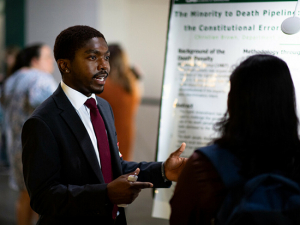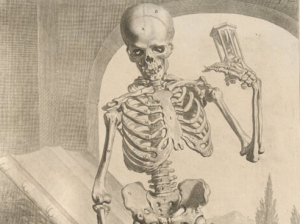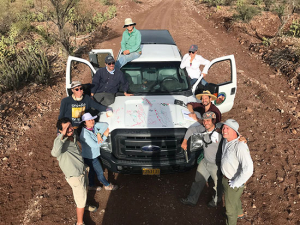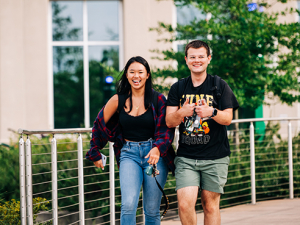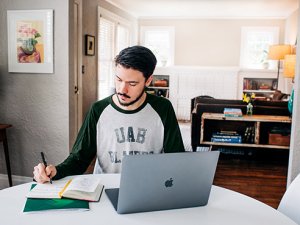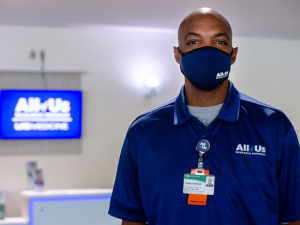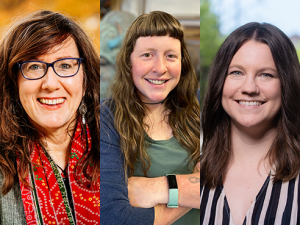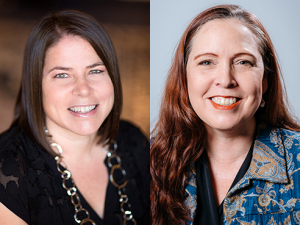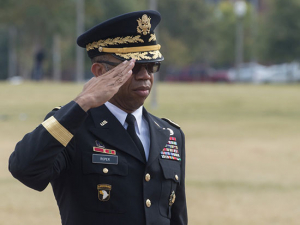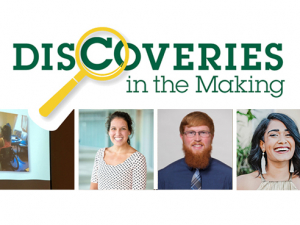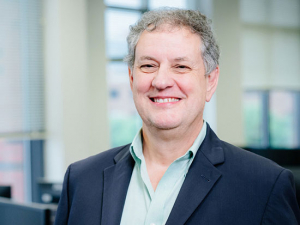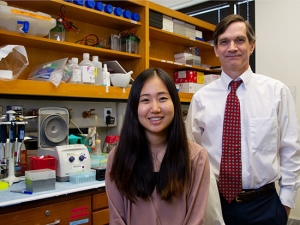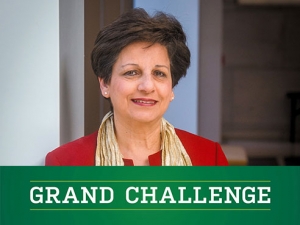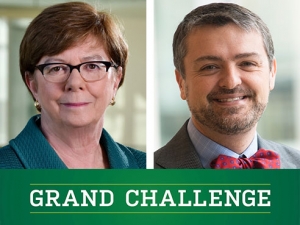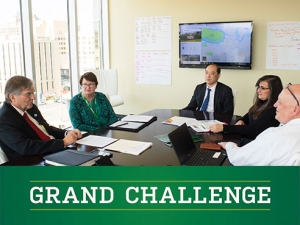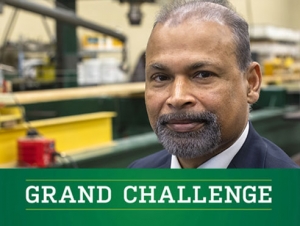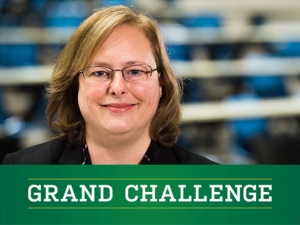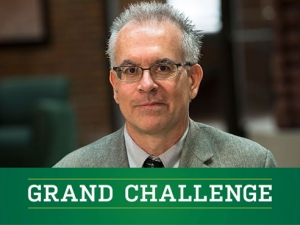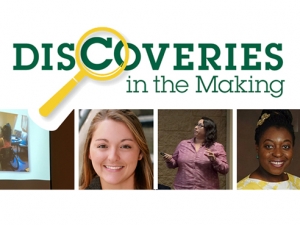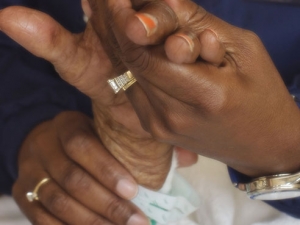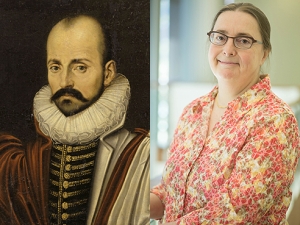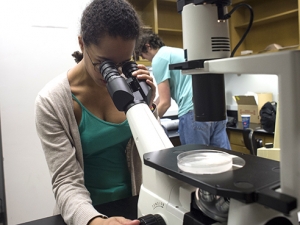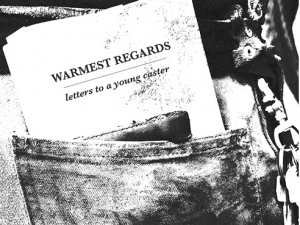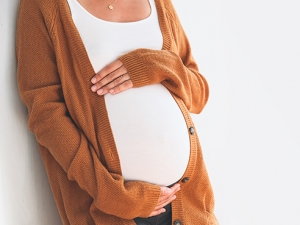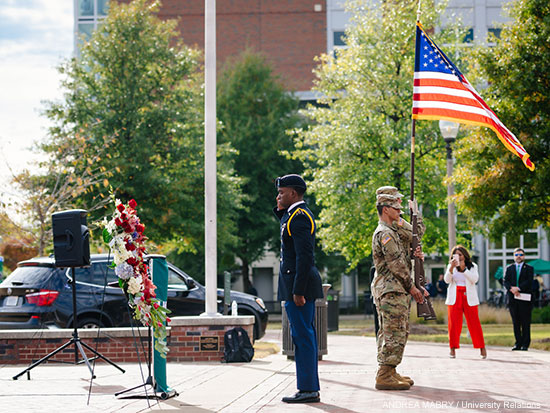 UAB ROTC Color Guard students posting colors at UAB's annual ceremony for Veterans Day in 2019. Veteran Services will host its sixth annual wreath-laying ceremony Nov. 11, live-streamed at 11 a.m. on the UAB Students Facebook page.For many veterans, the return home from a war zone doesn't bring the safety they must have imagined.
UAB ROTC Color Guard students posting colors at UAB's annual ceremony for Veterans Day in 2019. Veteran Services will host its sixth annual wreath-laying ceremony Nov. 11, live-streamed at 11 a.m. on the UAB Students Facebook page.For many veterans, the return home from a war zone doesn't bring the safety they must have imagined.
Approximately one-quarter of the 18 million veterans of the U.S. Armed Forces incur a disability during military service, according to data from the U.S. Census Bureau. Veterans who served during the Vietnam era make up the largest cohort of veterans, at 6.4 million; another 4 million served during peacetime only, 3.7 million served post-9/11 and 3.8 million served in the Gulf War. Age is not the only risk factor: Post-9/11 veterans have the highest chance of having a service-connected disability — 43%. Today, women comprise 9% of veterans, and that number is projected to grow to 17% by 2040.
“Veterans have distinctive experiences and health risks associated with their specific eras of service,” said Teena McGuinness, Ph.D., founding coordinator of the School of Nursing's Psychiatric Mental Health Nurse Practitioner Specialty Track, which began in 2008. (McGuinness retired from UAB in 2019). A veteran’s specific “era of service is often associated with health concerns and exposure to hazards," McGuinness said. "Exposures may be chemical — such as exposure to agent orange in Vietnam, biological — such as infection with leishmaniasis during the Gulf War, psychological — such as post-traumatic stress disorder or physical — such as blast injuries or limb loss in Iraq or Afghanistan.”
Veterans are “disproportionately impacted by a range of conditions, including trauma, substance abuse and mental health disorders such as post-traumatic stress disorder and its associated conditions such as sleep disorders, anxiety and increased risk for suicide,” McGuinness said.
UAB faculty are studying new ways to help America’s heroes heal and cope with major issues facing veterans, including rising rates of suicide and improving but still substantial rates of homelessness. Meanwhile, other researchers are pioneering autonomous vehicle technology that could lead to fewer battlefield injuries for soldiers on active duty. And UAB’s educational programs are attracting an increasing number of veterans who are looking to leverage their military expertise into new civilian careers.
Veterans and homelessness
In 2010, Secretary of Veterans Affairs Eric Shinseki and President Barack Obama announced a bold plan to end homelessness among veterans by 2015. Although the initiative fell short of that goal, VA initiatives likely contributed to a 50% reduction in homelessness," said Ann Elizabeth Montgomery, Ph.D., assistant professor in the School of Public Health's Department of Health Behavior. In addition, three states and 78 communities have effectively ended veteran homelessness, according to the Department of Housing and Urban Development. Montgomery has been conducting research on homelessness in veterans since 2009, when she joined the National Center on Homelessness among Veterans in Philadelphia.
In 2011, more than 65,000 veterans were experiencing homelessness according to the point-in-time counts taken annually on a single night at emergency shelters, transitional housing programs and unsheltered locations nationwide. By 2019, that total declined to a little more than 37,000 veterans.
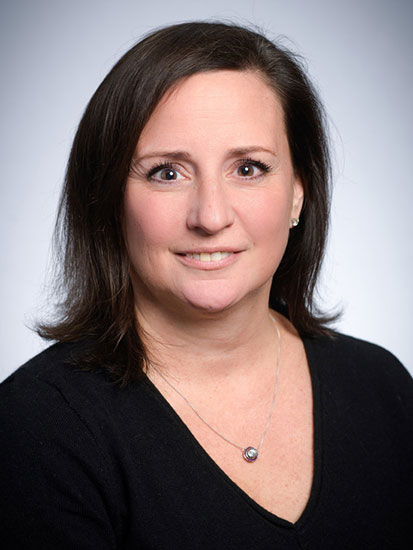 Ann Elizabeth Montgomery, Ph.D., assistant professor in the Department of Health Behavior, has been studying ways to reduce homelessness among veterans since 2009.One of the aspects of the VA’s effort to end homelessness is a universal screening program for housing instability in all outpatient clinics operated by the Veterans Health Administration. "Just like they ask if you wear a seatbelt or if you have used drugs, they will ask, 'Are you concerned about your housing?' and similar questions to evaluate a patient's risk," Montgomery said. "I worked with the group that developed those questions and we have been able to evaluate how well those questions have worked, as well as the incidence of homelessness among veterans in general, as well as special populations, including veterans who live in rural areas, veterans who are registered sex offenders or are transgender, for example."
Ann Elizabeth Montgomery, Ph.D., assistant professor in the Department of Health Behavior, has been studying ways to reduce homelessness among veterans since 2009.One of the aspects of the VA’s effort to end homelessness is a universal screening program for housing instability in all outpatient clinics operated by the Veterans Health Administration. "Just like they ask if you wear a seatbelt or if you have used drugs, they will ask, 'Are you concerned about your housing?' and similar questions to evaluate a patient's risk," Montgomery said. "I worked with the group that developed those questions and we have been able to evaluate how well those questions have worked, as well as the incidence of homelessness among veterans in general, as well as special populations, including veterans who live in rural areas, veterans who are registered sex offenders or are transgender, for example."
The Veterans Health Administration operates the nation's largest integrated health care system, Montgomery says, which is a unique advantage for researchers. "We have access to electronic health record data for 8 million veterans over a long period of time," she said. Analysis of this data has identified a number of veteran-specific experiences that increase the risk of homelessness. This includes military sexual trauma, from verbal harassment to rape or violence, which leads to an increased risk of homelessness for both women and men, Montgomery said. "Trauma related to sexual assault can have a bigger impact than trauma related to combat," she said. Post-traumatic stress disorder, often arising from non-combat issues, is prevalent among homeless veterans, as are substance abuse and mental health issues.
A study led by Stefan Kertesz, M.D., professor of medicine in the School of Medicine and a physician at the Birmingham VA Health Care System, surveyed more than 5,700 veterans nationwide who have experienced homelessness in what is the largest such survey to date. Writing in JAMA Network Open in March 2020, the researchers reported that 7.4% of those surveyed had had an overdose in the past three years, with alcohol the most commonly involved substance. “Alcohol use disorder is treatable with approved medications and interventions, such as motivational interviewing and cognitive behavioral therapy,” said lead author Kevin Riggs, M.D., assistant professor in the Division of Preventive Medicine. Opioids were the second most common cause of overdose. This study is one of several ongoing projects led by Kertesz that are focused on optimizing medical care for veterans.
Professor Stefan Kertesz, M.D., who directs a special primary care clinic for homeless veterans at the Birmingham VA Health Care System, spoke about ways ordinary people can make a difference in caring for the homeless and others in this TedXBirmingham talk in 2015.
In October, Montgomery began work on a new study funded by the VA's Office of Rural Health that will focus on homelessness outside urban centers. "There is not a lot known about rural homelessness," she said. "Most people think of it as an urban phenomenon, and that's where most services are located, but it is a problem in rural areas as well." The project will work with VA clinics in rural areas to identify those that are most and least successful in addressing homelessness among their patient populations. "We're going to interview providers in those areas and learn more about how to address the needs of this population," Montgomery said.
Story continues after image

Montgomery also has begun a new, three-year project to investigate whether services to address social determinants of health reduce suicide risk among veterans. "For veterans who have indicators of homelessness, justice involvement and unemployment, if they get services, does that reduce risk?" Montgomery said. "We will be using medical record data but also interviewing stakeholders and providers to understand how addressing homelessness can impact suicide prevention."
Another understudied area that Montgomery hopes to explore in future research are the unique needs of women veterans with children. "The number of women veterans is growing and their needs are not the same as male veterans," she said. "Women are far more likely to be homeless with children than men, for example. And when you have a woman who may have young dependent children, that really impacts the type of housing you can live in."
Although veterans have some unique circumstances, "their experiences are largely the same as many non-veterans who experience homelessness," Montgomery said. "What we learn in the VA is really applicable to homelessness as an American problem."
Story continues after box
Training a new workforce attuned to veterans' health and mental health needs
In 2009, the School of Nursing and the Birmingham VA Health Care System were designated as one of just 15 VA Nursing Academic Partnership (VANAP) sites in the United States. The goal of VANAP is to increase recruitment and retention of baccalaureate nursing students and graduates into the VA nursing workforce and to educate undergraduate nursing students about the specific needs of veterans. To date, more than 3,000 students have received education on "veteran-centric" competencies and 28 positions have been filled across the VA by UAB graduates.
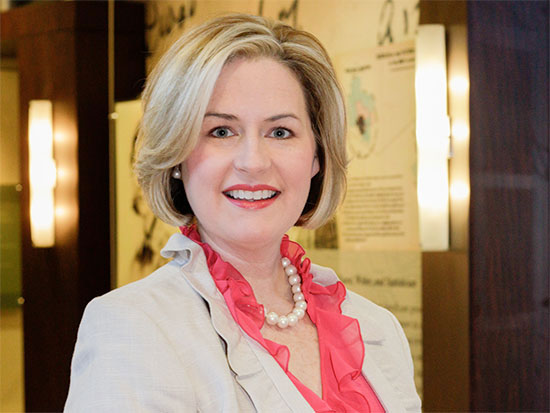 Aimee Holland, DNP, co-director of the School of Nursing's residency program for psychiatric mental health nurse practitionersIn 2014, the VANAP program at UAB expanded to include graduate education, known as VANAP-GE, and train psychiatric mental health nurse practitioners (PMHNPs). The first program of its kind in the United States, the goal is to create better access to mental health for veterans. Students in the program work closely with their preceptors and a team of physicians, social workers, psychologists and support staff in developing care plans for veterans in the Birmingham VA Health Care System. The School of Nursing-VA partnership also includes a one-year postbaccalaureate residency program for students who have completed PMHNP training.
Aimee Holland, DNP, co-director of the School of Nursing's residency program for psychiatric mental health nurse practitionersIn 2014, the VANAP program at UAB expanded to include graduate education, known as VANAP-GE, and train psychiatric mental health nurse practitioners (PMHNPs). The first program of its kind in the United States, the goal is to create better access to mental health for veterans. Students in the program work closely with their preceptors and a team of physicians, social workers, psychologists and support staff in developing care plans for veterans in the Birmingham VA Health Care System. The School of Nursing-VA partnership also includes a one-year postbaccalaureate residency program for students who have completed PMHNP training.
Faculty and residents in the VANAP-GE program have provided care to more than 12,000 veterans, and the Continuity Clinic staffed by PMHNP residents has provided measurement-based care to approximately 300 veterans. The two programs have led to 10 positions filled across the VA.
In fall 2019 there were 70 students in the PMHNP program, and 24 residents have been trained since the residency began in 2014. "Ten of those 24 have been hired by the Birmingham VA or other VA health care systems," said Aimee Holland, DNP, co-director of the residency program and assistant dean for Graduate Clinical Education in the School of Nursing. "Seven residents have gone on to pursue doctoral education, which prepares them to lead in nursing research and education."
| Since 2009, more than 3,000 students have received education on "veteran-centric" competencies and 28 positions have been filled across the VA by UAB Nursing graduates. |
Each cohort of residents engages in scholarly work. This year, three residents Rachel Shaw, Mariah McCrear and Scarlet Patterson — each with a master's degree in nursing and a certified registered nurse practitioner with PMHNP training — focused their work on suicide prevention among women veterans. "For women veterans, the suicide rate has increased nearly 50% since 2005, while the number of women veterans overall has only increased by 6.5%," Holland said. "This is a major issue." The residents noted that the suicide prevention efforts in VA clinics have significantly decreased suicide attempts among clinic patients. "They wanted to take that approach and translate it to clinics outside the VA system," Holland said. Shaw, McCrear and Patterson presented an abstract of their work during the Psychiatric Mental Health Nursing Association's annual conference in September. They also submitted an editorial to the Journal of Psychosocial Nursing and Mental Health Services, which will be published in February 2021, Holland said.
Veterans and UAB compensation analysts Gonzalo Ruiz and Kasey Whilding discuss their work and the benefits of Self-ID
Seeking answers, and treatments, for Gulf War Illness
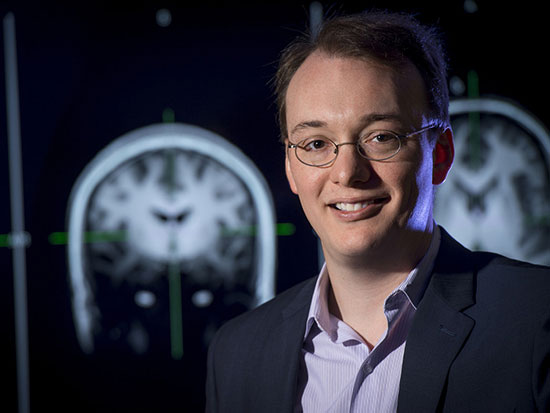 Jarred Younger, Ph.D., associate professor in the Department of Psychology, is using whole-brain imaging to examine the role of neuroinflammation in Gulf War Illness.Ever since the 1990-1991 Gulf War, military and civilian personnel who served in Iraq, Kuwait and surrounding areas — during that conflict or subsequent deployments and conflicts over the past several decades — have reported developing chronic, medically unexplained symptoms that can include fatigue, headache, joint pain, memory problems and insomnia. Known as Gulf War Illness, or Gulf War Syndrome, this condition is similar to fibromyalgia and chronic fatigue syndrome. And as with those other conditions, patients with Gulf War Illness are often told that medical tests can detect nothing wrong. The suggestion — overt or implied — is that the problem is all in their heads.
Jarred Younger, Ph.D., associate professor in the Department of Psychology, is using whole-brain imaging to examine the role of neuroinflammation in Gulf War Illness.Ever since the 1990-1991 Gulf War, military and civilian personnel who served in Iraq, Kuwait and surrounding areas — during that conflict or subsequent deployments and conflicts over the past several decades — have reported developing chronic, medically unexplained symptoms that can include fatigue, headache, joint pain, memory problems and insomnia. Known as Gulf War Illness, or Gulf War Syndrome, this condition is similar to fibromyalgia and chronic fatigue syndrome. And as with those other conditions, patients with Gulf War Illness are often told that medical tests can detect nothing wrong. The suggestion — overt or implied — is that the problem is all in their heads.
Jarred Younger, Ph.D., associate professor in the Department of Psychology and director of the Neuroinflammation, Pain and Fatigue Laboratory at UAB, believes that the problem in each condition is in fact in the head. Specifically, he has demonstrated, these conditions have a common origin in low-level inflammation in the brain. In 2019, Younger’s lab received a Department of Defense grant to assess neuroinflammation in Gulf War Illness using whole-brain magnetic resonance spectroscopy. “The main objective is to clearly show that Gulf War Illness is a neuroinflammatory disorder,” Younger said. “Because the population is aging — some of the Persian Gulf War veterans are now 70 years old — we are running out of time to effectively abolish the disorder. We want a neuroimaging scan that can definitively show that the condition involves inflammation in the brain. We hope that support will lead to prioritization of treatments to test, based on their ability to target brain inflammation.”
If the results of this study do implicate neuroinflammation, “then we will quickly transition to testing treatments that can cross the blood-brain barrier and target neuroinflammation,” Younger said. Those studies will likely test naltrexone, a drug used to treat opioid and alcohol addiction. Younger’s research has shown promising results for naltrexone at low doses in patients with fibromyalgia. “We have shown in a few papers that low-dose naltrexone helps fibromyalgia by reducing inflammatory cytokines [immune signaling molecules] in the blood,” Younger said. While he believes low-dose naltrexone could help Gulf War Illness in the same way, his lab has not yet been funded to do a clinical trial, Younger said. “There is also a form of naltrexone, dextro-naltrexone, that may be even more effective, that we are hopeful to get developed for human use as a possible treatment,” he added. “We are looking at all the options to determine which medicines may best reduce neuroinflammation for Gulf War Illness.”
Another potential treatment option may lie in plant-derived botanicals. With a Department of Defense grant, Younger’s lab conducted a clinical trial testing nine botanicals with anti-inflammatory properties in veterans with Gulf War Illness. Although the results are still moving through the publication process, Younger noted promising results in four botanicals: curcumin, French maritime pine, resveratrol and stinging nettle. “However, they will need to be tested in larger studies before they can be recommended to individuals with Gulf War Illness,” Younger said.
Helping veteran students succeed
UAB's enrollment of 22,563 students for fall 2020 includes more than 3,000 who are veterans of the U.S. Armed Forces. "That population is growing each semester at UAB," said Walter Stewart III, director of the Office of Veterans Services.
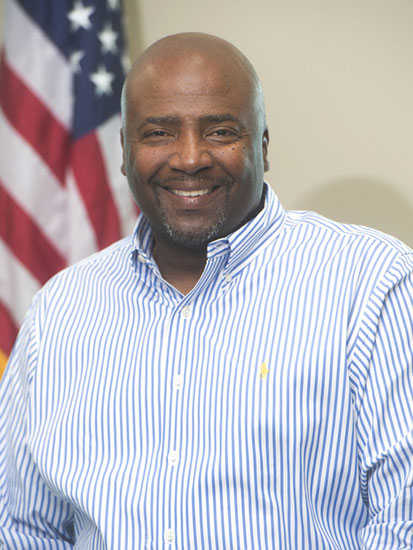 Walter Stewart III, director of UAB's Office of Veterans ServicesMany of those students are attracted by UAB’s highly ranked programs. Pete Dancy, CEO of the Alexandria VA Health Care System in Alexandria, Louisiana, served for 22 years in the U.S. Army’s Medical Service Corps, retiring in 2006 as a lieutenant colonel. He is now a student in the Executive DSc in Healthcare Leadership Program in the Department of Health Services Administration.
Walter Stewart III, director of UAB's Office of Veterans ServicesMany of those students are attracted by UAB’s highly ranked programs. Pete Dancy, CEO of the Alexandria VA Health Care System in Alexandria, Louisiana, served for 22 years in the U.S. Army’s Medical Service Corps, retiring in 2006 as a lieutenant colonel. He is now a student in the Executive DSc in Healthcare Leadership Program in the Department of Health Services Administration.
Dancy chose to return to school to pursue his doctorate “primarily in order to enhance my ability to lead health care organizations in this ever-changing environment,” he said. He also “wanted to demonstrate to my three sons that you are never too old to pursue an advanced degree.” As he was researching doctoral program, Dancy spoke to a Medical Service Corps colleague and good friend who had completed UAB’s program. “He spoke very highly of the program, particularly the caliber of the curriculum and faculty engagement,” Dancy said. Also, “the UAB program fit my desire to continue to work full-time while still allowing me to pursue an advanced degree.”
Dancy’s dissertation explores the extent to which the COVID-19 pandemic has influenced telemedicine use by veterans who live in rural communities. “Telemedicine is a critical component that expands the VA’s ability to care for veterans in rural locations,” Dancy said. “It is intended to offer modalities of care that are most often found in major cities or academic medical centers.” The Alexandria VA desires to be the health care provider of choice for veterans, Dancy said, and “telemedicine enables us to fulfill the desires of the veterans to have primary care, mental health, audiology, neurology, cardiology and other modalities close to their homes, in their communities. Because we serve veterans at all stages of life, from the relatively young adult recently off of active duty to the elderly who may have limited mobility, telemedicine offers all veterans the opportunity to use telemedicine in some fashion. Working veterans who are away from their primary care manager can connect securely with their cell phones. The elderly can connect at their homes.”
The coronavirus pandemic “has led to a dramatic shift in the use of telemedicine across the world,” Dancy said. “Health care organizations, including the VA, out of necessity are continuing to seek innovative ways to provide safe and effective health care through telemedicine.” His dissertation findings could point the way to new innovations. “I am hopeful that they can be used to understand the use of telemedicine, the dynamics regarding telemedicine use and how to further expand its use in rural populations,” Dancy said.
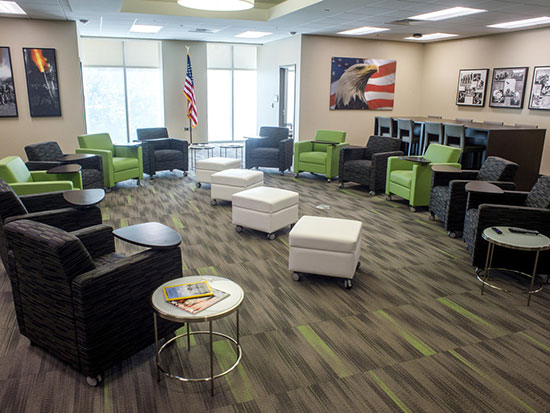 Veterans Services offices in the Hill Center includes space for veteran students to gather and study.UAB is the highest-ranked university in Alabama for military veterans for online bachelor's degree programs, according to U.S. News & World Report's Best Online Programs rankings, released in January 2020. UAB was ranked No. 15 for online bachelor's programs and No. 9 overall for online graduate information technology program. UAB also ranked No. 27 for veterans for its online MBA program.
Veterans Services offices in the Hill Center includes space for veteran students to gather and study.UAB is the highest-ranked university in Alabama for military veterans for online bachelor's degree programs, according to U.S. News & World Report's Best Online Programs rankings, released in January 2020. UAB was ranked No. 15 for online bachelor's programs and No. 9 overall for online graduate information technology program. UAB also ranked No. 27 for veterans for its online MBA program.
Veterans "are a very diverse group" that does not congregate in a few majors or programs but can be found across the university, Stewart said. "Each semester we have a dinner where we recognize student veterans who are graduating and give them the Veterans Graduation Cord, a red-white-and-blue cord to show our gratitude and respect for their commitment to our nation and to their studies," he said. (Veterans who have a 3.4 GPA or higher also receive a Challenge coin to mark their achievement.) "We have nurses, doctors, accountants, engineers — they are in all different programs," Stewart said.
Sgt. Matt Lentz, a student in the Physician Assistant Studies program in the School of Health Professions, served as a special operations medic during six years of active duty in the U.S. Army and then transitioned to the Alabama National Guard. He decided to become a PA “during my training pipeline in the Army," where he met several PAs and "was very impressed with their knowledge and decision-making capabilities," Lentz said. "I also think that within the medical field PAs have the most flexibility with choosing a job/specialty and have a great deal of autonomy as well." Lentz, who is from Florence, Alabama, chose UAB because of its location but also because of the history and identity of the PA program. "The PA program at UAB is one of the oldest in the country and one of the only programs with a surgical specialty interest," Lentz said. After he graduates, he will be working at Huntsville Hospital with a cardiothoracic surgery group.
In 2016, UAB expanded its commitment to the Yellow Ribbon scholarship program, offering unlimited Yellow Ribbon benefits to both graduate and undergraduate students who meet eligibility requirements. UAB also increased the maximum number of military credits that can be applied to a degree from four to 24. Veterans often have taken courses during their military training, such as classes in leadership and communications, that can be applied directly to a student's major. Student veterans also receive priority registration times, Stewart noted. "They can get their classes in and that will help them to be able to graduate on time."
In spring 2020, Stewart began offering Green Zone Training for faculty and staff. "The goal is to educate them on all that veterans bring to the table,” he said, “as well as the unique challenges they may face.”
Autonomous Vehicle Mobility Research Program aims to make soldiers safer and train students for cutting-edge careers
Another major reason veteran students choose UAB is the opportunity for hands-on training from experts in leading fields, from health care to business to engineering and beyond.
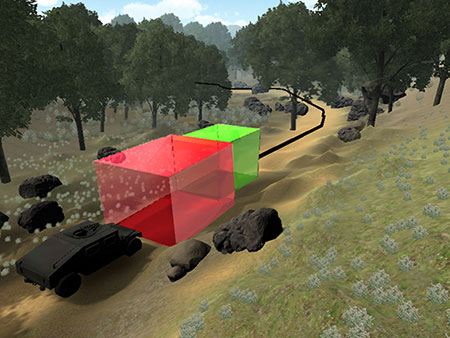 Jordan Whitson was a signals intelligence analyst in the Alabama National Guard, where he had first-hand experience with some of the latest in military vehicles improved in 2010 during his mobilization to Iraq, from the RG-33 mine-resistant ambush-protected (MRAP) vehicle to the Common Remotely Operated Weapon Station (CROWS), which enables soldiers to fire weapons without leaving the safety of their armored vehicles. Today, he is working on a new generation of autonomous military vehicles as a doctoral student in the School of Engineering.
Jordan Whitson was a signals intelligence analyst in the Alabama National Guard, where he had first-hand experience with some of the latest in military vehicles improved in 2010 during his mobilization to Iraq, from the RG-33 mine-resistant ambush-protected (MRAP) vehicle to the Common Remotely Operated Weapon Station (CROWS), which enables soldiers to fire weapons without leaving the safety of their armored vehicles. Today, he is working on a new generation of autonomous military vehicles as a doctoral student in the School of Engineering.
UAB engineering researchers are developing the first academic institute dedicated to autonomous mobility research and engineering, with $35 million in funding from the U.S. Department of Defense and the U.S. Army Combat Capabilities Development Command Ground Vehicle Systems Center. The goal is to help develop a national research lab-level facility to assist the Army with a new generation of combat vehicles that use artificial intelligence to allow personnel to direct the operations of unmanned ground systems.
The research program also will train warfighters to interact with autonomous vehicles using a unique hybrid simulation system. This Simulator of Autonomous Mobility (SAM) is a first-of-its-kind cyber-physical indoor proving ground, explains Vladimir Vantsevich, Ph.D., Sc.D., professor of mechanical engineering and director of the existing UAB Vehicle and Robotics Engineering Laboratory. Vantsevich will direct the autonomous vehicle mobility facility, while Lee Moradi, Ph.D., director of UAB’s Engineering and Innovative Technology Development research group, will be its general manager.
“SAM will allow drivers to practice simultaneously driving their own manned vehicles while communicating with autonomous vehicles,” Vantsevich said. Such human-machine hybrids could replace several human drivers with autonomous drivers in a battlefield re-supply convoy, for instance. Warfighters also will be able to practice controlling multiple autonomous vehicles remotely.
As autonomous vehicles move onto the battlefield, fewer soldiers will need to be placed in harm’s way. But UAB’s facility “is expected to advance vehicle technology transformation beyond the military sector” as well, Vantsevich said. Breakthroughs at UAB are expected to positively impact automotive engineering and manufacturing companies and research firms throughout the Southeast and beyond. “Truck engineering and trucking companies, construction equipment and farm tractor engineering in the United States desperately need such test facilities, which do not exist anywhere in the world,” Vantsevich said.
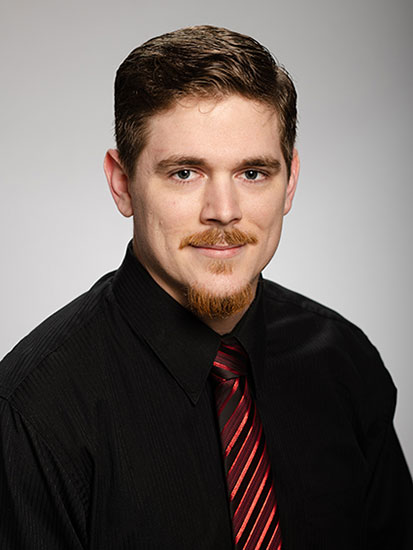 Engineering doctoral student and National Guard veteran Jordan Whitson is working on groundbreaking research on autonomous ground vehicles in a first-of-its-kind indoor vehicle proving ground at UAB.UAB’s facility should also draw students eager for cutting-edge training in what is expected to be a high-growth field. The School of Engineering is developing a new Master of Science degree in high-mobility vehicle engineering with the intent to become a hub for international academic and professional education, including military and civilians from member nations of the North Atlantic Treaty Organization, industry and partner universities in the Automotive Research Center. “I am particularly excited about the training opportunities these projects offer students interested in defense-related engineering careers,” said Jeff Holmes, M.D., Ph.D., dean of the School of Engineering.
Engineering doctoral student and National Guard veteran Jordan Whitson is working on groundbreaking research on autonomous ground vehicles in a first-of-its-kind indoor vehicle proving ground at UAB.UAB’s facility should also draw students eager for cutting-edge training in what is expected to be a high-growth field. The School of Engineering is developing a new Master of Science degree in high-mobility vehicle engineering with the intent to become a hub for international academic and professional education, including military and civilians from member nations of the North Atlantic Treaty Organization, industry and partner universities in the Automotive Research Center. “I am particularly excited about the training opportunities these projects offer students interested in defense-related engineering careers,” said Jeff Holmes, M.D., Ph.D., dean of the School of Engineering.
Whitson, a doctoral student in Vantsevich’s lab, has a head start on such a career. “I’ve always been interested how systems work and the details that make them function,” Whitson said. He came to UAB to get an undergraduate degree in engineering — “it was a toss-up between mechanical and electrical, and I ended up majoring in mechanical with a minor in electrical and additional classes in controls,” he said — but had no plans to stay on for advanced training. “I planned to get out and get a real job,” he said with a laugh. “But then I messed up and worked with Dr. Vantsevich as an undergraduate. He started telling me about his plans and I thought, ‘That sounds like a great idea.’”
Whitson earned a Science, Mathematics and Research for Transformation Scholarship for Service Program scholarship from the DOD, which is funding his graduate studies. He traveled to the DOD’s Ground Vehicle Systems Center in Detroit as part of his research with Vantsevich and “I got to meet the guys who are the think tank behind the systems I had used in the field,” Whitson said. “I was able to offer them some real-world critiques and experiences of what my unit saw in Afghanistan and Iraq, but also I got to understand the electronics and other systems. It was cool to flip from one side to the other.”
Whitson had always been intrigued by aviation and space (he started the UAB chapter of the American Institute of Aeronautics and Astronautics in 2018) and debated whether to pursue autonomous research in the air or on the ground. “I decided I would be happy on the ground,” he said. “I’m a Southerner and off-roading is near and dear. Learning the mathematics of wheel controls and torque controls is fascinating. The same things that Tesla can do on-road we want to do off-road. All the leading places are doing research on this: Ford, Toyota, Tesla, BAE Systems, Oshkosh, German companies and others are all trying to figure this out. Dr. Vantsevich’s approach holds a lot of promise.”
